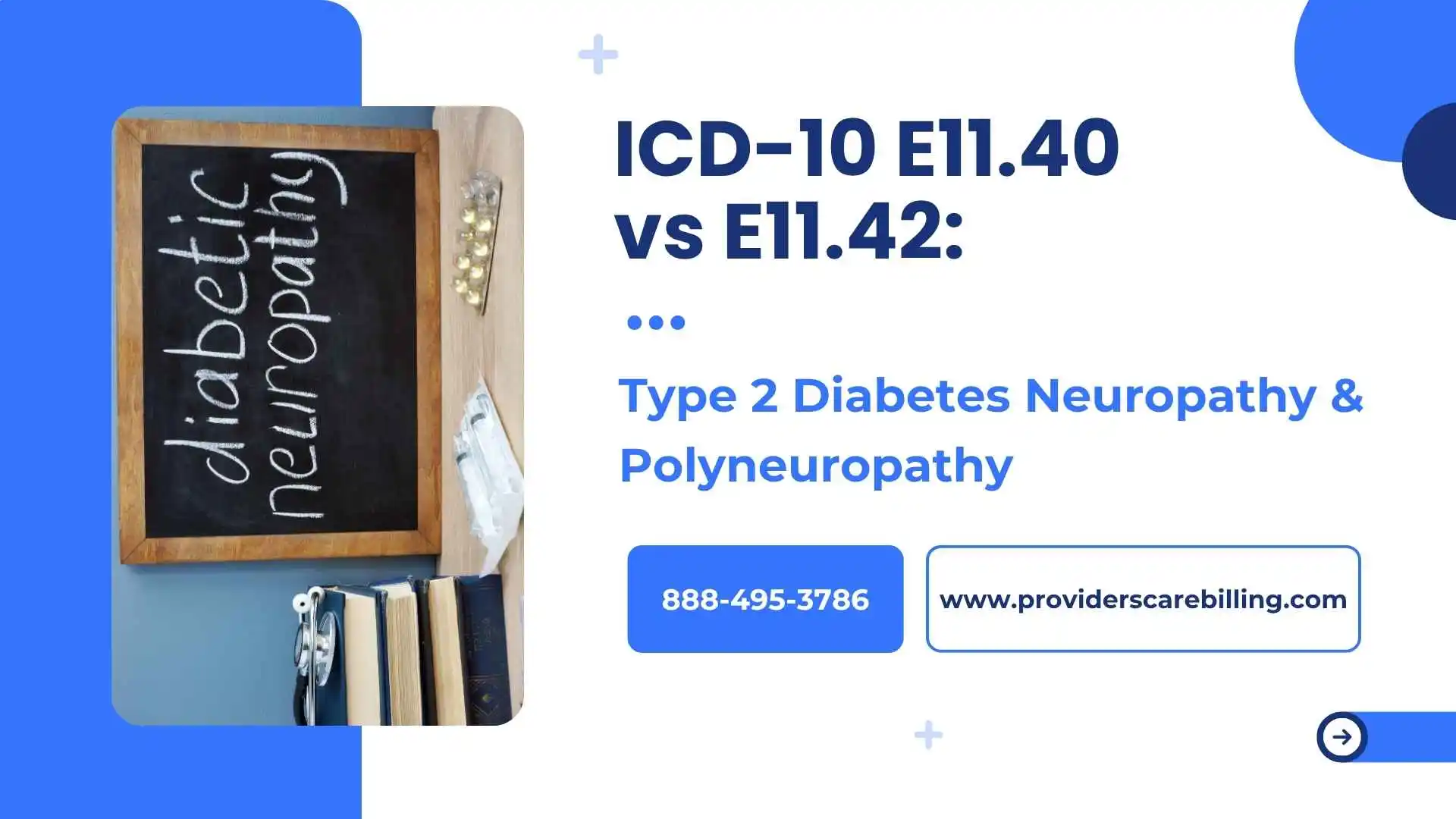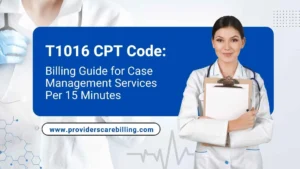Type 2 diabetes becomes severe if not treated properly. Over time, you may experience problems in your neurons. If it becomes serious, a patient may experience nerve damage, pain, tingling, and numbness. In the medical field, doctors use special codes to track this problem. Diabetic type 2 is identified in the documents using ICD-10 codes E11.40 and E11.42.
In this article, we’ll compare E11.40 vs E11.42 to help you understand when and how to use them accurately. Both seem similar, so that patients may get confused. But both have different meanings. E11.40 code is used when the problem is at the starting point, there is a problem, but you do not have pain. However, the E11.42 code represents nerve damage, and you may experience apparent symptoms of the disease.
Understanding their difference can help you avoid many problems, which we will discuss in our blog below. Let’s read and explore.
What Does E11.40 Mean?
When you see E11.40 on your bills, it means there is type 2 diabetes with diabetic neuropathy, but there are no signs. It means your patient is at the starting stage of nerve damage. Sometime after further inspection, it is revealed that there are no nerve issues. So, we can say it means an unspecified type of problem.
When E11.40 Code is Used?
Here are a few conditions when the E11.40 code is used.
- When your doctor confirms diabetic neuropathy, but does not specify its type.
- It is also used when a patient experiences pain, tingling, or numbness problems, but no medical notes are provided.
- E11.40 is used when medical records are unclear or incomplete.
Diagnostics should be determined based on the prevailing ICD-10 code or other relevant data for diabetic neuropathy, according to the state, or at least as detailed as possible. It is also strongly recommended during the initial evaluation or treatment of a patient.
How to Use E11.40 Correctly?
Here are the tips to use the E11.40 code properly.
- Only use this code when your documents tell you that you have diabetic neuropathy, but no specific details are available.
- If your documents tell you that you have polyneuropathy, then never use this code.
- You must include the symptoms, as it helps in later discussions or claims.
Billing Guidelines for E11.40
- Use E11.40 with CPT codes 99213 or 99214 for office visits.
- Also, remember to list your notes detailing any nerve-related symptoms.
- Expect to explain or justify the application of this code if it is used excessively, as it appears to be effective without further testing.
What Does E11.42 Mean?
E11.42 on your bills means type 2 diabetes mellitus with diabetic polyneuropathy. Using this code means a more specific version of E11.40. It tells your patient’s nerves are damaged, and the person is suffering from type 2 diabetes. This condition is called diabetic peripheral neuropathy.
When to Use E11.42?
Here is the list of conditions when the E11.42 code is used:
- The GG well documents polyneuropathy.
- The patient has pain, numbing, tingling, or burning in all five toes.
- The findings of tests that diagnose polyneuropathy, such as nerve conduction studies or EMG/NCS.
- A specialist, for example, a neurologist or podiatrist, had given a specific diagnosis.
This code is most suitable when you are dealing with dm with peripheral neuropathy ICD 10 situations.
How to Use E11.42 Correctly?
- Provide detailed notes about your patients’ symptoms, noting whether they are symmetrical.
- List diagnostic findings or specialist records.
- When complete documentation is available to support diabetic polyneuropathy, the ICD-10 code is used.
This code will help justify treatments such as physical therapy, foot care, or regular nerve checkups.
Billing Tips for E11.42
- CPT codes such as 95900 or 95903 for nerve studies, paired with 99214 for a comprehensive visit.
- Positive affirm that this condition is limiting the patient’s daily activities or movements.
- References or a special investigations report should be provided to support the diagnosis.
By using E11.42, even for conditions such as Mozart’s, is better approved because it provides a higher level of care, including physical therapy, and sufficient evidence supports this approach.
Quick Comparison Chart E11.40 VS E11.42
| Features | E11.40 | E11.42 |
| Description | Unspecified Diabetic Neuropathy | Specified diabetic polyneuropathy |
| Specificity | Low | High |
| Symptoms | General Sensory Problems | Pain, Tingling, Numbness |
| Diagnosis Requirements | No | Yes |
| Required Documents | Basic Notes | Detailed Notes |
| When Required | Early Stage | Confirmed Polyneuropathy |
| Billing Risk | May lead to claim delays or rejections | Supports better billing and advanced care |
Why is Proper Code Choice Important?
Choosing between E11.40 and E11.42 isn’t just a matter of numbers for the backroom concern of those who do patient care delivery, insurance payment administration, and maintain accurate medical reports – it has also clear implications for quality care.
Here’s Why It Matters So Much to Make Sure the Right Code for Diabetes Neuropathy Is Used:
- Fewer claim rejections: With any luck, insurers won’t quibble about this diagnosis number so much if it’s just used infrequently.
- Better justification for treatment: E11.42 supports treatment, whether it involves therapy, nerve tests, or referrals.
- More refined patient tracking: Using the proper code provides a clearer picture of a patient’s condition over time.
For instance, if an individual suffers from long-term damage due to severe nerve pain, it becomes visible to everyone by using E11.42 (as opposed to only E1140) what level of injury they have encountered.
ICD-10 Coding and Angina
A record of the angina ICD-10 codes may also be needed for a diabetic patient. This is because diabetes can also affect heart health. Suppose a person with diabetes displays chest pain or has coronary atherosclerosis. In that case, ICD code type 2 diabetes and cardiovascular codes are essential to document in place with the right words and according to diagnosis.
How do We Help at Providers Care Billing LLC?
We work closely with healthcare providers at Providers Care Billing LLC to ensure that conditions are coded correctly, for example, DM type 2 with neuropathy, using the ICD-10 coding system. Our team includes:
- Audit chart reviews to catch missed chances or the use of wrong codes
- Documentation support to help providers include the greater depth of detail that is required
Whether it’s E11.40 or E11.42 against any ICD-10 code for diabetic neuritis, the job we have is to get it right the very first time — because that saves time, money, and bother.
For providers managing pediatric and behavioral conditions, our guide on F84.0 – Autistic Disorder offers insights on recognizing, treating, and billing for childhood autism.
Quick Documentation Checklist
So, when coding neuropathy in type 2 diabetes, review the notes and check whether they answer these questions:
- Are symptoms like numbness, tingling, or burning described clearly?
- Are the symptoms symmetrical and multi-limbed?
- Has any nerve testing (like EMG) been performed or requested?
- Is there a corresponding report from a neurologist or relevant specialist?
- Are daily life activities related problems, such as movement problems, included or not?
- After that, you will decide whether to choose E11.40 or E11.42.
Final Words
Type 2 diabetes is often represented by E11.40 and E11.42, but both are used in different conditions. For the basic and starting condition, the E11.40 code is used when no detailed notes are included. However, when the condition is severe and detailed notes are available, the E11.42 code is used on bills.
Correct use of each code helps doctors, patients, and billing staff understand the type and use of these bills for further processing. It helps prevent delays and ensures timely treatment.
Are You Ready to Simplify Your Medical Coding?
If you’re a healthcare provider who is tired of coding confusion and billing delays, Providers Care Billing LLC is here to help. Our supporting staff will ensure that every claim is accurately coded, from diabetic peri-heptotropic ICD-10 to complex chronic disorders.
Contact us today to get the correct coding, faster payments, and fewer headaches.




